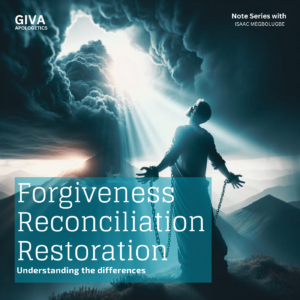Forgiveness, Reconciliation, and Restoration: Understanding the Differences

Isaac Megbolugbe
July 8, 2024
Forgiveness, reconciliation, and restoration are often used interchangeably, but they have distinct meanings and requirements. Understanding these differences is crucial for navigating complex relationships and conflicts.
_Forgiveness_
– Forgiveness is a solo process
– Requires letting go of negative emotions and feelings
– Releases the offender from obligation or debt
– Does not require the offender’s involvement or acknowledgment
– Focuses on the victim’s healing and release
_Reconciliation_
– Reconciliation requires both parties’ involvement and agreement
– Focuses on rebuilding the relationship
– Requires acknowledgment of wrongdoing and apology
– Involves rebuilding trust and communication
– Requires mutual effort and commitment
_Restoration_
– Restoration focuses on renewing and rebuilding relationships
– Requires forgiveness, reconciliation, and rebuilding trust
– Involves making amends and restitution
– Requires a commitment to moving forward and healing
– Focuses on the renewal of the relationship
_Key Differences_
– Forgiveness is a solo process, while reconciliation and restoration require both parties’ involvement.
– Forgiveness focuses on releasing negative emotions, while reconciliation and restoration focus on rebuilding relationships.
– Reconciliation requires acknowledgment of wrongdoing, while restoration requires making amends and restitution.
_Conclusion_
Understanding the differences between forgiveness, reconciliation, and restoration is crucial for navigating complex relationships and conflicts. By recognizing the distinct requirements for each process, we can seek healing, rebuilding, and renewal in our relationships.
_References_
– The Holy Bible (English Standard Version)
– Matthew 6:14-15; Matthew 5:23-24; Proverbs 17:9; Galatians 6:2; Hebrews 10:24-25